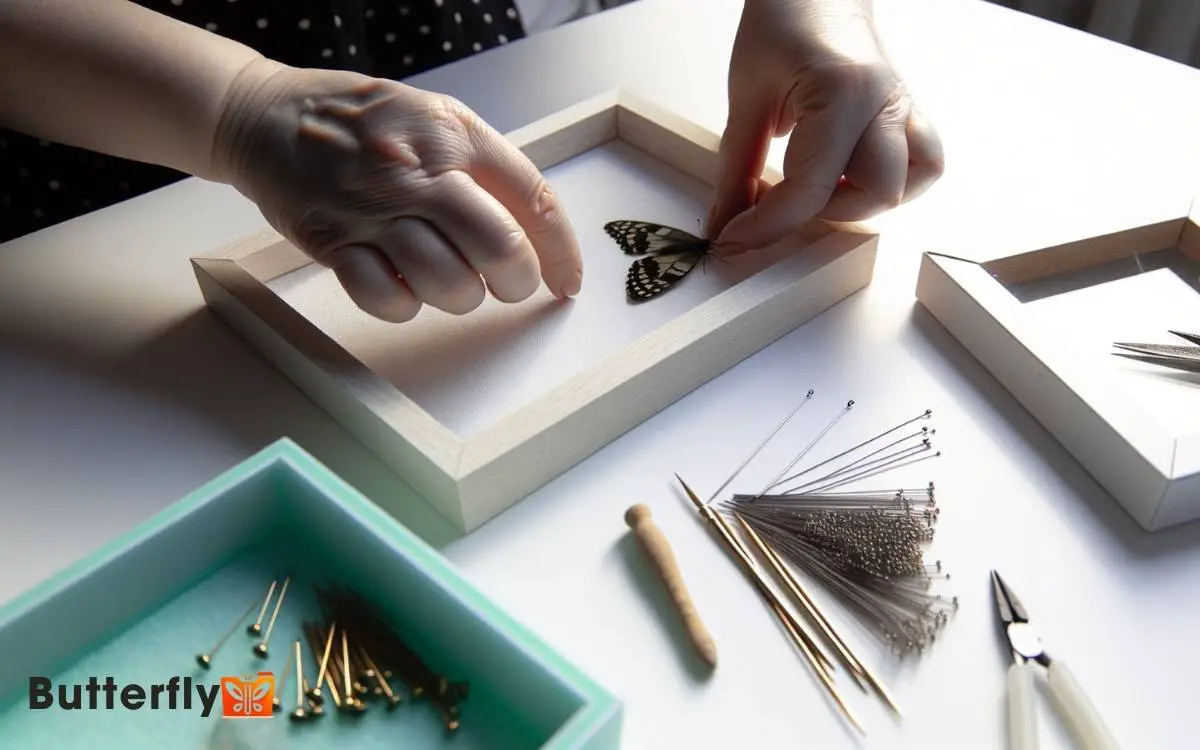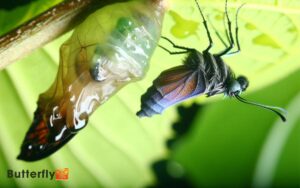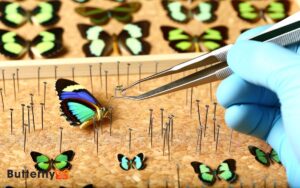How To Mount A Butterfly In A Shadow Box? Detailed Guide!
To mount a butterfly in a shadow box, start by selecting a vibrant, undamaged specimen like a Morpho peleides.
Gather your tools: a shadow box, mounting board, entomology pins, forceps, and a spreading board.
Hydrate the butterfly in a rehydration chamber and spread its wings using entomology pins on a spreading board.
Let it dry in a low-humidity environment. Position the butterfly in the center of the shadow box and secure it with fine-tipped pins.
Guarantee the display uses UV-protective glass and is sealed with archival tape. Place the mount gently and check it’s level for a professional finish. Discover more intricacies ahead.

Key Takeaways
Selecting the Right Butterfly
Choosing the right butterfly involves considering factors such as species, color, size, and condition to make sure it complements the aesthetic and scientific purpose of your shadow box.
Start by identifying which species aligns with your project’s theme. For a striking display, select butterflies with vibrant colors like Morpho peleides or Papilio ulysses. Consider the natural habitat and flight patterns of your chosen species to create an environment that best showcases their beauty. For a diverse selection, you might also include the alpine black swallowtail butterfly, known for its striking dark wings with subtle iridescence. Combining multiple species with complementary colors will enhance the visual appeal and create a dynamic, engaging display.
Size is essential; larger specimens like the Attacus atlas can dominate, while smaller ones like the Lycaenidae add subtlety.
Examine the condition meticulously; avoid damaged wings or faded colors, as they detract from the visual and scientific value. Utilize a magnifying glass to inspect for parasites or deformities.
Preparing Your Materials
To begin, gather all necessary materials, including a shadow box, mounting board, entomology pins, forceps, and a spreading board. Make sure the shadow box has UV-protective glass to prevent fading. The mounting board should be acid-free to avoid discoloration.
Use fine-tipped forceps to handle the butterfly delicately. Entomology pins, preferably stainless steel, will secure the specimen without corrosion. The spreading board, with adjustable slots, allows you to position the wings symmetrically.
Lay out these tools on a clean, flat surface to maintain an organized workspace. Precision and cleanliness are essential for a professional display.
By preparing these materials meticulously, you’ll guarantee the butterfly’s aesthetic and structural integrity is maintained throughout the mounting process.
Proper Butterfly Preservation
Once your materials are ready, you need to focus on proper butterfly preservation to guarantee the specimen remains intact and vibrant for display. Begin by rehydrating the butterfly if it’s dried out.
Place it in a rehydration chamber, such as a sealed container with damp paper towels and a few drops of an antifungal agent to prevent mold. Leave it for 24-48 hours.
Next, carefully relax the wings using entomological pins on a spreading board. Position the wings symmetrically to avoid damage.
Allow the butterfly to dry in this position for several days in a low-humidity environment. This ensures it retains its shape and color.
Mounting the Butterfly
Position the butterfly in the center of the shadow box using entomological pins to secure its body and wings without causing damage.
Insert the pins gently through the thorax, making sure they pass through the central axis. Spread the wings using forceps, placing pins strategically to hold them in a natural, symmetrical position.
Be meticulous; the wings are delicate and can easily tear. Use fine-tipped pins for precision. Maintain a steady hand and avoid excessive pressure.
If the butterfly’s legs are uneven, adjust them carefully with tweezers. Achieve a lifelike posture by referencing anatomical diagrams.
This method guarantees the specimen remains undamaged and aesthetically pleasing. Your precise technique will lead to a professional, innovative display.
Final Display Assembly
Safely secure the mounted butterfly within the shadow box frame, guaranteeing that all components are aligned and stable for a perfect display.
Place the butterfly mount gently into the pre-measured backing, using acid-free adhesive or entomological pins to prevent damage. Confirm the wings remain flat and symmetrical.
Utilize UV-protective glass to shield the specimen from light degradation. Finally, seal the shadow box with archival-quality tape to prevent dust and contaminants from entering. Double-check that the display is level and no adhesives are visible.
Each step ensures that your butterfly remains preserved and visually striking, combining aesthetic appeal with scientific integrity.
This meticulous approach guarantees your display is both innovative and enduring, showcasing your specimen with precision and care.
Conclusion
Mounting a butterfly in a shadow box not only preserves its beauty but also contributes to scientific studies.
Did you know that there are over 17,500 butterfly species worldwide?
By following meticulous preservation and mounting techniques, you guarantee that your specimen remains intact and visually appealing.
Remember, each step—from selecting the right butterfly to the final display assembly—requires precision.
Your careful attention to detail will result in a stunning, scientifically valuable display.






